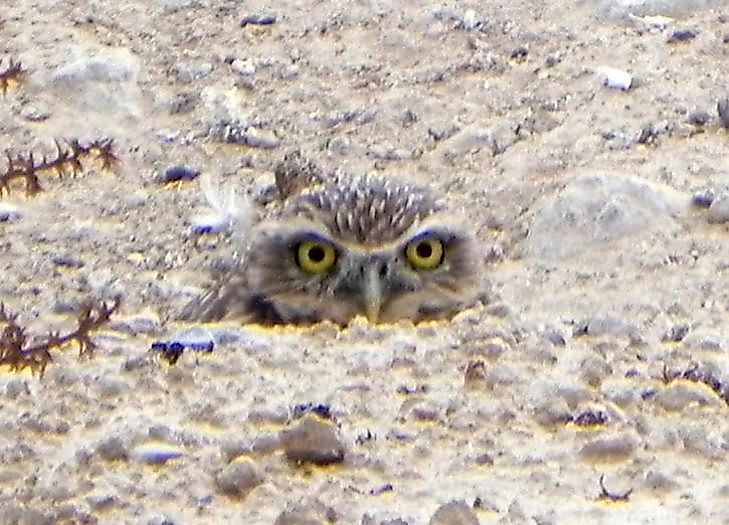Burrowing Owl Facts: Animals of North America

5. Physical Description
The Burrowing owl (Athene cunicularia) is one of the smallest owls in the Americas, usually reaching a length of only 9 inches, with a wingspan of less than two feet. It has black feathers with patches of white spots. Its underside is white with brown bar-shaped spots. It has a white chin and large yellow eyes. Its body color helps them to avoid predation and blend in with vegetation in their habitat. Burrowing owls are a ground-dwelling species and, as their common name alludes to, they like to take over the former burrows of other animals, especially those of Prairie Dogs. Long legs relative to their small size and an absence of ear tufts are some of their most identifiable characteristics. The Borrowing owl is around 7.5 to 10 inches tall, and weighs around 4.5 to 9 ounces. The wingspan of this bird is usually between 21 and 24 inches. Male birds are slightly heavier than females, and their wingspans are typically longer as well.
4. Diet
Borrowing owls eat reptiles, amphibians, small animals, insects, and other birds depending on food availability and season. These birds are most active at dawn and dusk. However, some birds hunt during day and night alike. They consume more small mammals at night, and more insects during the day.
3. Habitat and Range
Burrowing Owls are found in almost any open space, including desert habitats, agricultural and range lands, and dry grasslands. They are often associated with areas also having burrowing animals, such as badgers, ground squirrels, and prairie dogs, whose former in-ground homes they often make their nests within. They may also live within stands of Ponderosa Pine and Pinyon. Burrowing Owls commonly perch on top of mounds outside of their burrows, or upon fence posts. Winter populations can be found in Mexico and Central America. Summer breeding populations can be seen mostly in the US, from the Midwest to the east, the eastern parts of Pacific states to the west, the Mexican border to the south, and into Canada to the north. Year-round, Burrowing Owls may be seen in Mexico, Florida, and parts of South America, excluding the Amazon Rainforest. The greatest threat to the Burrowing owl is habitat degradation and the destruction caused by human development activities. These are protected birds, but they are often displaced and their burrows destroyed during the process of land development. Though the natural lifespan of this bird is 6-8 years, it is generally shorter, as they are also at risk of predation from feral cats and dogs, birds of prey, and coyotes. Due to the increase in suburban and urban sprawl, automobiles are also hazardous to burrowing owls. Populations of burrowing owls are declining in some areas due to concurrent poisonings of prairie dog colonies, agricultural pesticide use, and automobile collisions. Burrowing owls are conserved differently in different regions, but they are listed as “Endangered” or “Threatened” in most.
2. Behavior
Unlike other owls, the burrowing owl is very active during the day. They are most active in spring, when they gather and store up food for their large broods. They prefer to live in open areas with little ground cover. Burrowing Owls make a tremendous chattering or chuckling call and they bob their heads to express distress or excitement. During nesting season, the bird will collect a wide variety of materials for their nest, which they often make in the in-ground “burrows” dug by other animals that were these burrows' former residents. Although not exclusively nocturnal like some other owls, they typically avoid being out in the heat and light midday.
1. Reproduction
Mating season for the Burrowing Owl is in early spring, and their gestation period is 28 days. The bird reaches sexual maturity at around one year of age. Female owls lay around 6-11 pure white eggs in a chamber. Both parents help to incubate the eggs before hatching for around 28 days.











